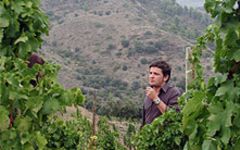Alvaro Palacios L'Ermita 1996
-
Robert
Parker -
Wine
Spectator

Product Details
Your Rating
Somm Note
Winemaker Notes
Professional Ratings
-
Robert Parker's Wine Advocate
The 1996 L'Ermita appears to be another blockbuster effort from Alvaro Palacios. The color is a saturated purple. The expressive nose boasts aromas of pain grille, roasted coffee, chocolate-covered, jammy cherry candy, minerals, and new oak. Full-bodied, dense, and thick, with an unctuous texture, lower acidity, and higher alcohol than the 1995 and 1994, this is a meaty, chewy, masculine wine with a flamboyant personality, in addition to a monster finish. It is super-intense, but exceptionally well-balanced, especially in view of its proportions. Rating 95-96.
-
Wine Spectator
Elegant and focused, this firm, graceful red offers crisp black cherry and cassis flavors, with lead pencil and cigar box accents, much like a fine Bordeaux. Not a blockbuster, it's impressive for its excellent backbone and definition. Best after 2002. 550 cases made.
Other Vintages
2004-
Robert
Parker
-
Robert
Parker -
Wine
Spectator
-
Wine
Spectator -
Robert
Parker


Recently named the 2015 "Man of the Year" by Decanter Magazine , Alvaro Palacios is an important figure in the wine industry. This prestigious title is awarded to people who have made an exceptional contribution to the universe of wine.
The son of the owners of Rioja's Palacios Remondo, Alvaro Palacios spent his early 20s working and studying winemaking outside of Spain. His experience abroad - particularly in Bordeaux - instilled in him a deep passion for great wines and led him to return to Spain with the ambition to make wines that could be world-class. To achieve this dream, Palacios was drawn to the historic hillsides of slate soil and its traditional grape varieties of Garnacha and Carinena. Now widely considered to be among the more important new Spanish wineries in a generation, Alvaro Palacios embodies the spirit of "The New Spain."

Grenache thrives in any warm, Mediterranean climate where ample sunlight allows its clusters to achieve full phenolic ripeness. While Grenache's birthplace is Spain (there called Garnacha), today it is more recognized as the key player in the red blends of the Southern Rhône, namely Châteauneuf-du-Pape, Côtes du Rhône and its villages. Somm Secret—The Italian island of Sardinia produces bold, rustic, single varietal Grenache (there called Cannonau). California, Washington and Australia have achieved found success with Grenache, both flying solo and in blends.

Tiny and entirely composed of craggy, jagged and deeply terraced vineyards, Priorat is a Catalan wine-producing region that was virtually abandoned until the early 1990s. This Spanish wine's renaissance came with the arrival of one man, René Barbier, who recognized the region’s forgotten potential. He banded with five friends to create five “Clos” in the village of Gratallops. Their aim was to revive some of Priorat’s ancient Carignan vines, as well as plant new—mainly French—varieties. These winemakers were technically skilled, well-trained and locally inspired; not surprisingly their results were a far cry from the few rustic and overly fermented wines already produced.
This movement escalated Priorat’s popularity for a few reasons. Its new wines were modern and made with well-recognized varieties, namely old Carignan and Grenache blended with Syrah, Cabernet Sauvignon and Merlot. When the demand arrived, scarcity commanded higher prices and as the region discovered its new acclaim, investors came running from near and far. Within ten years, the area under vine practically doubled.
Priorat’s steep slopes of licorella (brown and black slate) and quartzite soils, protection from the cold winds of the Siera de Monstant and a lack of water, leading to incredibly low vine yields, all work together to make the region’s wines unique. While similar blends could and are produced elsewhere, the mineral essence and unprecedented concentration of a Priorat wine is unmistakable.
